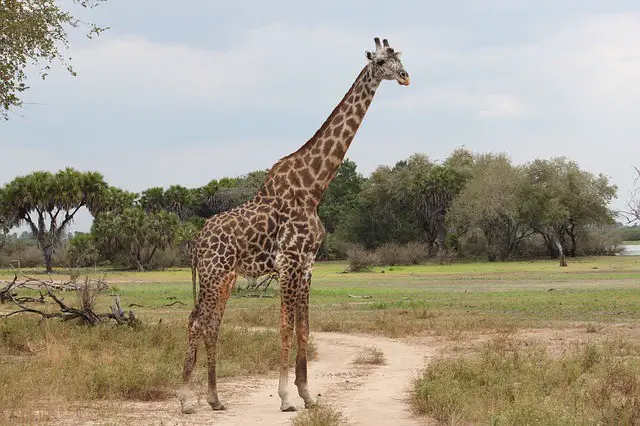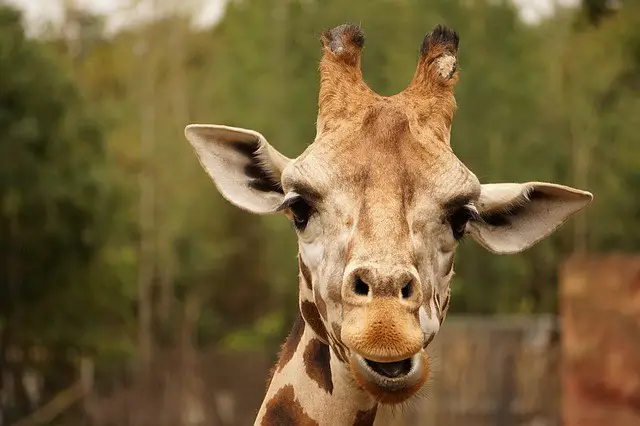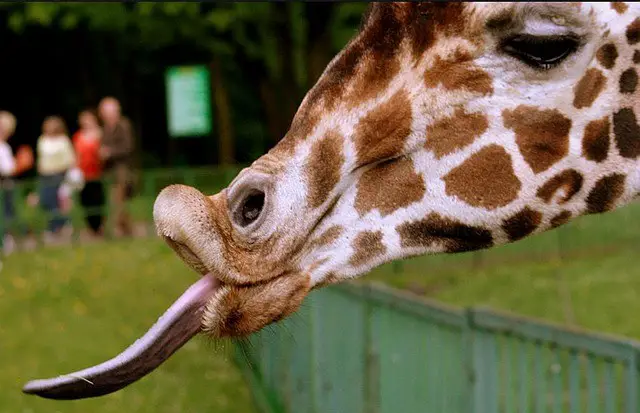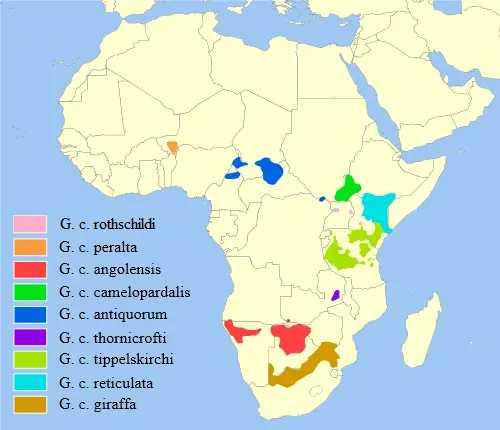The giraffe is the tallest animal in the world. Due to its unique appearance and immense height, Giraffe is well known among kids. Giraffe has always been the center of attraction in zoos and kids are often curious about them. We have gathered a complete set of Giraffe Facts For Kids that will answer all the questions that your kids might have in their minds about the Giraffe. You are going to learn all about Giraffes including their meaning, appearance, scientific name, classification, height weight, neck, legs, tails, horns, teeth, hair, ears, heart, feet, stomach, lifespan, diet, speeds, sleep, habitat, male, female, lifecycle, reproduction, babies, species, population, endangerment, predators, adaptations and many other interesting facts about Giraffe.
Giraffe Facts For Kids
1. What Is A Giraffe
- The giraffe is a mammal, an even-toed-ungulate, and the living tallest terrestrial animal in the world.
- It is also the world’s largest ruminant (animals that have a rumen, an extra special chamber in the stomach where microbial fermentation of the plant-based food occurs).
- It is native to Sub-Saharan Africa, where they are found in open woodlands, savannahs, and grasslands.

2. Giraffe Meaning – Giraffe Meaning In English
- The known earliest origin of the name “giraffe” is the Arabic word “زرافة” (Zarafah), which means “fast walker”.
- In Middle English, there were several spellings of the name, such as “ziraph”, “jarraf”, and “gerfauntz”.
- The current English form of the animal’s name “Giraffe” arose in about 1600 from “girafe”, the French name of the animal.
3. What Do Giraffes Look Like – Giraffe Description
- A giraffe has long legs and neck, which makes them the tallest mammal on land.
- The coat color is mostly grey with a distinct pattern of patches or blotches of dark brown to blackish color.
- It has a small but long head and round-shaped mouth
- A giraffe has two bulging eyes and two ears at both sides of the head.
- On top of the head, it has two horn-like structures known as ossicones.
- Giraffe also has a long tail, which is probably the longest in mammals.
- Male individuals are usually taller than females.

4. What Are Giraffes Related To
- The living closest relative of the giraffe is okapi (Okapia johnstoni), which is also known as the forest giraffe.
- The genera of giraffe and okapi belong to the same family Giraffidae.
- The closest living relatives of both giraffe and okapi are cows, deer, musk deer, and pronghorns.
5. Giraffe Scientific Name
- The scientific name of the giraffe is “Giraffa”.
6. Giraffe Classification
- The following is the scientific classification or taxonomy of giraffes:
| Kingdom | Animalia |
| Phylum | Chordata |
| Sub-phylum | Vertebrata |
| Class | Mammalia |
| Order | Artiodactyla |
| Family | Giraffidae |
| Genus | Giraffa |
7. How Tall Is A Giraffe – Giraffe Height
- The height of a full-grown giraffe is up to 14.1 to 18.7 feet (4.3 to 5.7 meters).
- Males are usually taller than females.
Tallest Giraffe In The World – Biggest Giraffe In The World
- The recorded tallest male giraffe in the world was 19.3 feet (5.88 meters) tall.
- While the recorded tallest female was 17.0 feet (5.17 meters) tall.
Tallest Giraffe Ever
- The tallest giraffe ever was a male Masai giraffe at the British Zoo.
- It was named George and its height was 19.3 feet (5.88 meters).

8. How Much Does A Giraffe Weigh – Giraffe Weight
- The average weight of an adult male giraffe is 2,628 pounds (1,192 kg), and of an adult female giraffe is 1,825 pounds (828 kg).
- The recorded maximum weight of an adult male giraffe is 4,250 pounds (1,930 kg) and of an adult female is 2,600 pounds (1,180 kg).
Fattest Giraffe In The World
- Binky is probably the fattest giraffe in the world.
- It is an 8 years old male giraffe in the Serengeti National Park of Tanzania, which weighs more than 900 pounds.
9. How Long Is A Giraffe Neck – Giraffe Neck Facts
- A full-grown giraffe has up to 2 to 2.4 meters (6.6 to 7.9 feet) long neck.
- It weighs about 272 kg (600 pounds).
- There are no extra vertebrae in a giraffe’s neck.
- But the cervical vertebrae (neck vertebrae) are too much enlarged, which gives it extraordinary length.
- The length of each cervical vertebrae is over 11 inches (28 cm).
- The neck of a giraffe makes up 52 to 54% of all the length of the vertebral column.
- For us, a giraffe’s neck is very long, however, it is too short for them to reach the ground.
- To drink water, a giraffe kneels or spreads its front legs to reach its mouth to water.
10. How Many Teeth Do Giraffes Have – Giraffe Teeth Facts
- Like human beings, a giraffe has 32 teeth.
- They have incisors located on the front of their lower jaw.
- On the front region of their upper jaw, they have a hard pad-like structure.
- To strip off leaves from trees, a giraffe uses its incisors, pad, and its long tongue.
- At the back position of their upper and lower jaws, they have molars.
- There is a region of several inches with no teeth between molars and front teeth.
- A giraffe uses its molars to grind food, as well as to chew the cud (a giraffe is ruminant and chew its cud).
11. How Long Is A Giraffe’s Tail – Giraffe Tail Facts
- A giraffe has a 2.5 to 3.2 feet (0.7 to 1 meter) long tail.
- It has about 18 coccygeal vertebrae.
- Their tail is considered the longest of all land mammals.
- The tail ends on a long and dark color tuft of hair.
- Like all grazing animals, a giraffe’s tail acts like a fly swatter and its primary use is a defense against biting insects.
12. Giraffe Horns Facts – Giraffe Ossicones Facts
- The giraffe does not have actual horns.
- But rather, both male and female giraffes have horn-like structures on the top of their heads called ossicones.
- The ossicones are made up of ossified cartilage.
- They are fused with the parietal bones of the skull and are covered with skin.
- Ossicones have blood vessels and may play a role in controlling body temperature.
- Male giraffes also use their ossicones during combat.
- The ossicones of young giraffes and females are thin in size and have a tuft of hair on their top region.
- While the ossicones of males have a round ball-like ending and do not have hair on the top.

13. Giraffe Tongue Facts
- A giraffe has up to 18 inches (45 cm) long tongue.
- It is dark purple-black and covered with taste buds.
- The dark color probably protects from sunburn.
- It is prehensile due to which they can easily grasp foliage.
- A giraffe also uses its tongue for cleaning and grooming its neck, ears, and nostrils.

14. Giraffe Hair
- Giraffes have hard and thick skin covered with short, soft, and fine hair or fur.
- In the fur, there are at least 11 aromatic chemicals.
- The chemicals, especially indole and 3-methyl indole, give a characteristic scent to the giraffe.
- The fur with chemicals is an excellent defense as it has parasite repellent qualities.
- Giraffes also have a mane of short and erect hair along the entire length of the neck.
15. Giraffe Ears
- A giraffe has two ears located on the sides of ossicones at the top of the head.
- Giraffes have a good sense of hearing.
16. How Many Hearts Does A Giraffe Have – Giraffe Heart Facts
- A giraffe has only one heart.
- It has more than 25 pounds (11 kg) weight while up to 2 feet (60 cm) in length.
- The heart has up to 3 inches (7.5 cm) thick walls.
- It is powerful enough to pump blood along the long neck to the brain and the entire body.
- The usual heart rate of a giraffe is 50 beats per minute, which is high for its size.
- The blood pressure of a giraffe is approximately double that of humans, which is necessary for the maintenance of blood flow to the brain.
17. How Long Are Giraffes Legs
- A giraffe has about 1.8 meters (6 feet) long legs.
- The back legs look slightly shorter, however, both the front and back legs have similar lengths.
18. Giraffe Feet – Giraffe Foot
- The giraffe is an even-toed ungulate.
- It means each foot of the giraffe has two hooves, which bear equal weight.
- The foot has a diameter of up to 12 inches (30 cm).
- In males, every hoof is about 5.9 inches (15 cm) high while in females it is 3.9 inches (10 cm) high.
- Every hoof has a low rear or back and the fetlock joints (metacarpophalangeal and metatarsophalangeal joints) are close to the ground.
- It provides extra support to the body weight of the animal.
- The dewclaws and interdigital glands are absent in giraffes.
- The legs and feet of giraffes have extremely tight skin, which prevents the flow and accumulation of too much blood in the feet.
19. Giraffe Spine
- Spine means a series of vertebrae from the skull to the end of the back.
- A giraffe has 7 cervical or neck vertebrae like humans and most other mammals.
- Vertebrae in the neck region are long, which is the reason for the exceptional size of a giraffe’s neck.
- The neck vertebrae are also bound together through ball-and-socket joints, which provide extra flexibility to the animal’s neck.
- The number of thoracic vertebrae in giraffes is 14.
- They have 5 lumbar vertebrae.
- Giraffes have a short sacrum with only 4 vertebrae.
- All three types of vertebrae in the back part are short and fine.
- Coccygeal or tail vertebrae in a giraffe are 18.
20. How Many Stomachs Does A Giraffe Have
- A giraffe has only one stomach.
- However, a giraffe is ruminant so its stomach is composed of 4 separate chambers just like other ruminants.
- A giraffe chews food and then swallows.
- The half-digested food (cud) passes through the neck and then back to the mouth for chewing again.
21. How Long Do Giraffes Live – Giraffe Lifespan – Giraffe Age
- As compared to other ruminants, the giraffe has a long age.
- The average lifespan of a giraffe is up to 25 years in the wild.
How Long Do Giraffes Live In Captivity
- A giraffe lives for up to 38 years in captivity.
How Long Do Giraffes Live In The Wild
- In the wild, a giraffe live for up to 25 years.
22. What Do Giraffes Eat – Giraffe Diet
- Giraffes are herbivores in nature.
- They mostly eat the twigs and foliage of trees, shrubs, grasses, and fruits.
- The daily diet of a giraffe is about 75 pounds (34 kg) of foliage.
- The twigs and leaves of the trees of the subfamily Acacieae and the genera Terminalia and Commiphora is their favorite diet. These are rich in proteins and calcium and sustain the growth rate of the giraffe.
- As compared to other herbivores, giraffes require less food as they feed on the foliage which has a high amount of nutrients.
23. Giraffe Eating Habits
- In wet seasons when food is widely available, giraffes spread out over a long area.
- While in dry seasons, they are found gathering around the remaining evergreen bushes and trees.
- To make sure security and to easily detect predators, mothers usually tend to feed in open regions.
- A giraffe is ruminant so it chews food, swallows, and then again chew the cud.
- Giraffes usually salivate during feeding.
- In case of stress, giraffes chew the bark off tree branches.
- Giraffes are also observed visiting the dead bodies of other animals and licking the dried meat.
24. How Fast Can A Giraffe Run – Giraffe Speed
- The maximum speed of a giraffe for short bursts is 60 km/hr.
- They can run at a speed of 50 km/hr (31 mph) for several miles.
25. Giraffe Sitting
- When sitting down, a giraffe kneels on its front legs and then moves down the rest of its body.
26. How Many Hours Do Giraffes Sleep – Giraffe Sleeping Facts
- In captivity, a giraffe gets a sleep of about 4.6 hours per day at irregular intervals.
- They mostly sleep at night in a laying down position.
- Older individuals sometimes also sleep in a standing position.
- During a short intermittent phase of “deep sleep”, a giraffe bent its neck into the backside and rests the head on thigh or hip. Sleeping in this position is considered to indicate paradoxical sleep.
- In the wild, a giraffe needs only 5 to 30 minutes of sleep and it gets it through short and quick naps.
27. How Long Have Giraffes Been Around
- Modern giraffes evolved within 6 million years.
- They are found only about one million years ago.
28. Where Do Giraffes Come From
- Scientific studies show that giraffes evolved from ungulate animals found in Eurasia and Africa about 25 million years ago during the Miocene Age.
- After their emergence, their ancestors became extinct.
29. Where Do Giraffes Live – Giraffe Habitat Facts
- Giraffes are native to the continent of Africa.
- They are usually found in open woodlands and savannas where they can easily watch predators from long distances and can flee quickly.
- Giraffes usually avoid denser environments, such as the woodlands of the genus Brachystegia.
- The open woodlands of Acacia, Combretum, Terminalia, and Commiphora is their favorite habitat.
- Giraffes flourish in habitats having hot climates.
- Their home range is between 20 and 129 km².
30. Where Are Giraffes Found – Giraffes In The Wild
- Giraffes are found in the Sub-Saharan region of Africa.
- All the subspecies of giraffes are found in the same habitat of savannas, open woodlands, and forests.
- The remaining giraffes in the wild are less than 100,000 individuals.
- The reticulated or Somali giraffes (Giraffa reticulata) are found in the southern regions of Ethiopia and Somalia. They also live in the northeast regions of Kenya. An estimated number of about 450 individuals also live in captivity throughout the world.
- The Masai giraffes (Giraffa camelopardalis tippelskirchi) are indigenous to East Africa, where they are found in Tanzania and the Central and Southern regions of Kenya.
- The South African or Cape giraffes (Giraffa giraffa giraffa) are found in the northern region of South Africa, the south of Zimbabwe and Botswana, and the southwest region of Mozambique.
- The Nigerian or West African giraffe (Giraffa camelopardalis peralta) are found in the southwest regions of Niger, where they live mostly in the Niger River basin.
- The Nubian giraffes (Giraffa camelopardalis camelopardalis) are found in the South-west regions of Ethiopia and Southern Sudan.
- The Namibian or Angolan giraffes (Giraffa camelopardalis angolensis) are found in the northern regions of Namibia, in the south-western regions of Botswana and Zambia, and western Zimbabwe.
- The Kordofan giraffes (Giraffa camelopardalis antiquorum) are found in the northern regions of Cameron, southern regions of Chad, Central African Republic, and very few in Sudan.
- The Rothschild giraffes (Giraffa camlepardalis rothschildi) are found in Uganda and Kenya.
- The Rhodesian giraffe (Giraffa camelopardalis thornicrofti) is native to Zambia, where they are mostly found in the valley of Luangwa.
31. Giraffe Habitat Map

32. Giraffe In Swahili
- In the Swahili language, a giraffe is known as “Twiga”.
33. Male Giraffe Facts – What Is A Male Giraffe Called
- A male giraffe is called a “Bull”.
- Male giraffes have a large size of up to 19 feet in height and a maximum bodyweight of up to 1,930 kg.
- The coat color of male giraffes becomes darker with age.
- Male giraffes have thick ossicones with bald tips.
- They also have a stronger odor.
- Male giraffes are less social and attempt to establish dominance among the herd through clashing and sparing their horns and through “necking” with other males.
34. Female Giraffe Facts – What Is A Female Giraffe Called
- A female giraffe is called a “Cow”.
- Female giraffes are of a small size than males with up to 17 feet height and a maximum bodyweight of up to 1,180 kg.
- Females have thinner ossicones with dense hair.
- They are more social and completely responsible for parenting newborns.
- Female giraffes are also more selective than males when foraging for food.
35. Giraffe Life Cycle
- The lifecycle of giraffes starts when they are born after a gestation period of 14 to 15 months.
- Females usually become sexually mature earlier at the age of 4 years.
- Males mature at the age of 4 to 5 years, however, they gain the opportunity of mating at the age of at least 7 years.
- A giraffe lives for up to 25 years in the wild and the maximum age of 38 years in captivity.
36. Giraffe Gestation Period – Giraffe Reproduction
- In giraffes, the reproduction is widely polygamous and an older male may mate with several females.
- Males detect fertile females through testing and detecting oestrus in their urine.
- Males usually avoid juvenile and older females and prefer young adult females.
- There is no specific mating season for giraffes and they may mate throughout the year.
- The gestation period in giraffes is 14 to 15 months.
- Giraffes usually bear a single calf and twins are very rare.
- The mother feeds the young ones for only a month or for a maximum time of a year.
37. Giraffe Birth Facts
- In captivity, the births of giraffes occur throughout the year.
- However, in the wild, the young ones are usually born during the dry seasons.
- A female giraffe stands up when she gives birth.
- The calf is born with his head and front legs first and falls to the ground with the break off of the umbilical cord.
- The mother helps the newborn to stand up and then grooms him.
38. How Many Babies Do Giraffes Have
- Giraffes usually have a single baby.
- Twins may also be born sometimes but are very rare.
39. Baby Giraffe Facts – Newborn Giraffe – Newborn Baby Giraffe
- A newborn baby giraffe has 1.7 to 2 meters of height and a weight of 47 to 70 kg.
- It starts running after a few hours of its birth.
- At birth, it has flat ossicones, which become erect within a few days.
- The baby giraffe spends most of its time hiding for the first 1 to 3 weeks of its life.
- During the first week of life, a calf grows about 3 centimeters per day.
- The calves are vulnerable and the mothers watch over them and protect them from predators.
- When a mother goes somewhere else for drinking or foraging, she sometimes left her calf in a nursery herd.
- The calves are fed with the mother’s milk for a time of one month to one year.
- The calves become completely independent at the age of 15 to 18 months, after which they do not need the protection of their mother.
What Is A Baby Giraffe Called
- A baby giraffe is called a “calf”.
How Tall Is A Baby Giraffe
- A baby giraffe is about 5.6 to 6.6 feet (1.7 to 2 meters) tall at birth.
How Much Does A Baby Giraffe Weigh
- At birth, a baby giraffe weighs up to 104 to 154 pounds (47 to 70 kg).
40. How Many Species Of Giraffes Are There – Types Of Giraffes
- According to IUCN, there is only one species of giraffe, which is further divided into 9 subspecies.
- In 2007, a genetic study of Giraffa suggested the existence of 6 species; the West African, South African, Rothschild’s, Masai, Reticulated, and Angolan giraffe.
- A 2011 study, based on the analysis of giraffe’s morphology and the application of cladistic or phylogenetic species concept, suggests the existence of 8 species of living giraffes. These are:
- Angolan giraffe or Namibian giraffe (G. angolensis)
- Kordofan giraffe (G. antiquorum)
- South African or Cape giraffe (G. giraffa)
- Nubian giraffe or Baringo giraffe or Ugandan giraffe (G. camelopardalis)
- Reticulated giraffe or Somali giraffe (G. reticulata)
- West African giraffe or Niger or Nigerian giraffe (G. peralta)
- Masai giraffe or Kilimanjaro giraffe (G. tippelskirchi)
- Thornicroft’s giraffe or Luangwa giraffe or Rhodesian giraffe (G. thornicrofti)
41. Northern Giraffe
- The northern giraffe (Giraffa camelopardalis) is a proposed giraffe species.
- It is also called a three-horned giraffe.
- Northern giraffes are indigenous to North Africa.
- There are three proposed subspecies of the northern giraffe:
- Nubian giraffe (Giraffa camelopardalis camelopardalis)
- Kordofan giraffe (Giraffa camelopardalis antiquorum)
- The West African giraffe (Giraffa camelopardalis peralta)
- While the Rothschild’s giraffe (Giraffa camelopardalis rothschildi) is considered as its ecotype.
- The current population of northern giraffes is 5,195.
42. Southern Giraffe
- The Southern giraffe (Giraffa giraffa) is another proposed species of giraffe.
- It is also called a two-horned giraffe and is indigenous to Southern Africa.
- Their habitat range includes South Africa, Angola, Namibia, Zambia, Zimbabwe, Botswana, and Mozambique.
- The current population of the southern giraffe is estimated as 44,500 individuals.
- There are two proposed subspecies of the southern giraffe:
- Angolan giraffe (Giraffa giraffa angolensis)
- South African or Cape giraffe (Giraffa giraffa giraffa)
- However, the IUCN recognizes only a single species of giraffe, which has 9 subspecies.
43. Masai Giraffe Facts – Maasai Giraffe
- The Masai giraffe (Giraffa camelopardalis tippelskirchi) is also known as Kilimanjaro giraffe.
- It is a subspecies of giraffes indigenous to East Africa.
- They are found throughout Tanzania and in the southern regions of Kenya.
- Individuals of Masai giraffes are the largest among all the 9 subspecies, which makes them the tallest land animals on the planet earth.
- Their population in the wild is estimated as 32,550 individuals.
44. South African Giraffe Facts
- The South African giraffe (Giraffa camelopardalis giraffa) is also called Cape giraffe.
- It is a subspecies of giraffes found in South Africa, Namibia, Zimbabwe, Mozambique, and Botswana.
- They have darkly rounded or blotched spots on the tawny color background on the skin.
- In 2016, their estimated population in the wild was 31,500 individuals.
45. West African Giraffe Facts
- The West African giraffe (Giraffa giraffa peralta) is a subspecies of giraffe also known as Niger giraffe or Nigerian giraffe.
- They inhabit the Sahel areas of West Africa.
- They have light color spots on their skin which makes them easily distinguishable from other subspecies.
- In 2016, their population was estimated as 400 to 450 individuals in the wild.
46. Rothschild’s Giraffe Facts
- Rothschild’s giraffe (Giraffa camelopardalis rothschildi) is a subspecies of giraffe also known as Baringo giraffe.
- They are found in open woodlands, savannahs, and the grasslands of Kenya and Uganda.
- The patch pattern on their coat resembles the Masai giraffe.
- However, the patches on its skin are sharper and less jagged with a cream color background as compared to the Masai giraffe.
- Rothschild’s giraffes have five ossicones; two at the top of the head just like other giraffes, one at the center of the forehead, and two behind the ears.
- In 2016, their population was estimated at 1,669 individuals.
47. Reticulated Giraffe Facts – Giraffa Reticulata
- Reticulated giraffe (Giraffa camelopardalis reticulata) is a subspecies of giraffe indigenous to the Horn of Africa.
- It is also known as the Somali giraffe and is found in Somalia, northern Kenya, and southern Ethiopia.
- The coat of reticulated giraffe has reddish-brown or liver color large polygonal spots. A network of bright white lines separates the spots.
- Their population in the wild is estimated as 8,500 individuals.
48. Kordofan Giraffe
- Kordofan giraffe (Giraffa camelopardalis antiquorum) is a giraffe subspecies.
- It is found in southern Chad, northern Cameron, the Central African Republic, and possibly in some regions of Sudan.
- The individuals of this subspecies have a relatively smaller size as compared to other subspecies.
- Their estimated population in the wild is 2,000 individuals.
49. Angolan Giraffe
- The Angolan giraffe (Giraffa giraffa angolensis) is a giraffe subspecies found in the northern regions of Namibia, western Zimbabwe, south-western regions of Zambia, and Botswana.
- It is also known as the Namibian giraffe.
- Angolan giraffes have a large brown blotch pattern on the skin. The upper part of the face does not have any spots.
- Their estimated population in the wild is 13,000 individuals.
50. Rhodesian Giraffe
- The Rhodesian giraffe (Giraffa cameloperdalis thornicrofti) is a giraffe subspecies.
- Most commonly, they are known as Thornicroft’s giraffes.
- This subspecies is found only in the south Luangwa Valley of Zambia.
- Their estimated population in the wild is only 550 individuals.
51. Zebra Giraffe – Half Zebra Half Giraffe – Okapi Giraffe
- Okapi is also known as the zebra-giraffe, the forest giraffe, half zebra half giraffe, and Congolese giraffe.
- It is an even-toed ungulate mammal indigenous to the northeast regions of the Democratic Republic of the Congo.
- Despite having stripped marking on the legs like a zebra, the okapi is the close relative of the giraffe.
- Okapi and giraffe share the family Giraffidae and both are the only living species of this family.
- Male okapis have ossicones like a giraffe.
- They are found in canopy forest habitats.
- Okapi is on the list of endangered species of the IUCN Red List.
52. How Many Giraffes Are Left In The World – Giraffe Population
- According to the 2016 estimation, the population of Giraffa in the wild is 97,500 individuals.
- At the Specie360 registered zoos, there were more than 1,600 giraffes in captivity in 2010.
- However, it is unknown how many giraffes are there in non-Species360 registered zoos or private captivity of other people.
53. Are Giraffes Endangered – Are Giraffes On The Endangered Species List
- In 2016, the IUCN listed giraffes as “Vulnerable”.
- It means its population is decreasing and they are likely to become endangered if the conditions are not improved that causing threats to its survival.
- The Masai and Reticulated subspecies are listed as “endangered” while the Nubian subspecies are listed as “critically endangered”.
- The subspecies Rothschild’s giraffe is listed as “near threatened”.
54. Are Black Giraffes Endangered – Melanistic Giraffe
- When a male giraffe reaches the age of 9.5 to 10 years, the spots on its skin become dark due to which it looks black.
- The dark color is due to a large amount of melanin in their skin.
- Some researchers argue that the dark color is related to the social behavior of a giraffe rather than its age.
- The IUCN listed three subspecies of giraffes as “critically endangered”. So obviously, aged males of dark color and other melanistic giraffes of these subspecies are endangered too.
55. White Giraffe – Albino Giraffe – Are White Giraffes Endangered
- White giraffes are extremely rare among giraffes.
- A female white giraffe and a baby were observed in Kenya.
- They were considered albinos (a genetic condition in which all the body organs can not produce pigments). However, they were not albinos (albino animals have pink eyes).
- Their white color was due to leucism, a genetic condition in which skin cells can not produce pigments. However, other organs such as eyes can produce pigments and are colored.
- Such a condition was also observed in a baby giraffe at Tarangire National Park of Tanzania.
- Their white skin does not cause any genetic disadvantage to their survival.
- However, Giraffe Conservation Foundation says that white giraffes are the easy targets of predators such as lions and hyenas, as their white skin does not provide them any camouflage.
56. Are Giraffes Going Extinct – Giraffe Extinction Facts
- Giraffes have been locally extinct from much of their historic habitat range including Guinea, Eritrea, Senegal, and Mauritania.
- The remaining population of the giraffe is fragmented and faces so many threats.
- Loss of habitat is the number one threat to their survival while poaching for its skin and body parts and predation by other wild animals also causes the reduction of its population.
- The IUCN listed giraffes as “vulnerable”, which means they are at the highest risk of extinction.
57. Giraffe Extinct – Prehistoric Giraffe
- The following are the extinct prehistoric species of giraffes lived during the Pliocene, Pleistocene, and Miocene epoch:
-
- Giraffa jumae
- Giraffa priscilla
- Giraffa pygmaea
- Giraffa sivalensis
- Giraffa stillei
- Giraffa gracilis
- Giraffa punjabiensis
58. Giraffe Predators
- Lions are the primary natural predators of giraffes.
- To hunt an adult giraffe, the whole pride of lions usually cooperates.
- Leopards, hyenas, and wild dogs hunt the vulnerable baby and juvenile giraffes.
- Giraffes sometimes also become prey to the Nile crocodiles when they bend down to drink water.
- Human beings are the most dangerous predators of giraffes and kill them for their skin, meat, and trophy hunting.
59. Are Giraffes Dangerous – Are Giraffes Friendly
- Giraffes are not dangerous to humans.
- They are friendly and are observed eating from the hands of humans.
- However, if threatened it’s one kick can cause serious harm.
60. Giraffe Adaptations
Giraffes have several adaptations, which help them to survive in their natural habitat. These adaptations include:
-
Long neck
The long neck of a giraffe allows them to eat leaves of long trees. It also helps them to see a long way in all directions. Due to their long necks, they can detect threats and see predators from a long distance, and have time to flee. That is why giraffes have a long lifespan among ruminants.
-
Strong and prehensile tongue
A giraffe has up to an 18-inch long prehensile tongue, which can twist, wrap-around, and can grasp things. The upper lip of giraffes is also prehensile and is covered with hair, which protects them from thorns when foraging. The purple-black color of the tongue acts like sunscreen and protects from sunburn.
-
Coat or Skin
Giraffes have tough skin with a pattern of blotches or patches of dark red-brown or blackish-brown color. The pattern on the coat provides them camouflage. Under the dark regions of the skin, complex blood vessels and large sweat glands lay that act like thermoregulating windows. Their thick skin allows them to run unaffected between thorny bushes. The fur also has chemicals with parasite repellent qualities and provides them a chemical defense.
-
Water needs
Giraffes do not need to drink water at short intervals. They usually drink water at intervals of a few days, mostly after 3 days. A giraffe can also drink a large amount of water, about 10 gallons at a time. It is a good adaptation as their long neck is too short for them to reach the ground and they must bend on their knees to drink water. Bending on knees makes them vulnerable to predators, especially crocodiles and lions.
61. Pygmy Giraffe – Small Giraffe – Giraffe With Dwarfism
- According to Fossilworks, Giraffa pygmaea was a species of the giraffe that lived during the Pliocene epoch.
- It was found in Africa and became extinct about 0.781 million years ago during the Pleistocene epoch.
- Giraffa pygmaea was of a smaller size than the modern giraffes.
62. Harold The Giraffe
- Harold the giraffe is an 11-year-old giraffe at Werribee Open Range Zoo, in Australia.
63. April The Giraffe – April The Giraffe Baby
- April the Giraffe is a female reticulated giraffe held at the Animal Adventure Park in New York, USA.
- She was born in 2002 at the Catskill Game Farm in New York.
- She was relocated to Animal Adventure Park in 2015.
- In 2017, she gained worldwide attention when she was pregnant with her 4th child, Tajiri.
- About 1.2 million viewers watched the live video of her giving birth.
- She gave birth to another calf, her 5th baby on March 16, 2019, which was named Azizi.
64. Tajiri The Giraffe – Tajiri Giraffe
- Tajiri the Giraffe is the 4th child of April the Giraffe living at the Animal Adventure Park.
- Tajiri is a male giraffe born on April 15, 2017.
- His birth gained worldwide fame and was watched live by 1.2 million people.
- His name “Tajiri” is taken from the Swahili language, which means “hope”.
65. Marius The Giraffe
- Marius the giraffe was a male giraffe born on 6 February 2012 at Copenhagen Zoo, Denmark.
- It was a healthy giraffe but was found genetically unsuitable for breeding.
- So the zoo authorities kill him on 9 February 2014, and then its body was publicly dissected.
- The event of his killing and dissection gained worldwide media coverage.
- People and Animal Rights Organizations critically respond to the decision of his killing.
66. George The Giraffe
- George the Giraffe is a male Masai giraffe at the Kansas City Zoo, Missouri, United States.
- He was born on March 15, 2014.
67. Giraffe Problems
- Giraffe Problems is a book written for kids by Jory John.
68. Camel And Giraffe
- The following are some of the common features between a camel and a giraffe:
- Both are mammals.
- Both are even-toed ungulates (belongs to the order Artiodactyla).
- Both are ruminants.
- The genetic divergence of the ancestors of both occurred about 50 million years ago.
69. Giraffe For Sale – Giraffe Cost – Baby Giraffe For Sale – Pet Giraffe – Giraffe Price
- A giraffe is an exotic animal and having its private ownership is illegal in many countries and many states of the USA.
- Some countries permit private ownership.
- Many people throughout the world have a giraffe as a pet.
- The average cost or price for a healthy giraffe is in the range of $40,000 to $80,000.
70. World Giraffe Day
- Every year, 21 June is celebrated as world giraffe day.
- Giraffe Conservation Foundation started its celebration.
- 21 June was selected as it is the longest day of the year and the giraffe is the tallest animal on the land.
71. Giraffe Safari
- Safari means an expedition to see or hunt animals in their natural habitats.
- Some of the best sites to see a giraffe on safari are:
- Murchison National Park, Uganda
- Northern Selous, Tanzania
- Chyulu Hills, Kenya
- Meru National Park, Kenya
- South Luangwa, Zambia
72. Amazing Facts About Giraffe
- A giraffe is the tallest terrestrial mammal on the planet earth.
- The coat pattern of giraffes is unique for every individual just like the fingerprints of humans.
- In 24 hours, a giraffe needs only 5 to 30 minutes of sleep.
- Giraffes are very social and live in groups called “towers”. The group usually has 15 members and an adult male led the group.
- Mother giraffes gather in nursery herds and usually walk and browse together. When a mother needs to drink water or forage somewhere else, she left her calf with another female. This behavior of caring for other offspring is known as “Creche” or “Calving Pool”.
- Male giraffes fight to establish dominance. They hit their long necks and heads. This behavior is known as “Necking”. Their fights are usually not dangerous and end when a male admits his defeat and walks out.
- The steps of a giraffe during a normal walk are about 15 feet long.
- A giraffe’s kick is its effective defense, which is strong enough to kill a lion.
- A folktale from Eastern Africa explains that the giraffe got its height due to eating too many magic herbs.
- Julius Caesar brought the first giraffe to Rome in 46 BC.
73. Weird Giraffe Facts
- A giraffe could look into a window of the second story while standing at its normal height.
- An adult giraffe has up to 6 feet long legs, which are taller than humans of normal height.
- The life of a giraffe was spent mostly standing up.
- The blood pressure of a giraffe is double that of a human.
- The world’s recorded oldest giraffe in the wild was “Chopper the Giraffe”.








